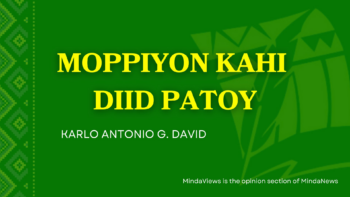
MALAYBALAY CITY (MindaNews / 12 May) — Pablo Torre, a Filipino-American sportswriter, drew criticisms for wearing a Sablay from the University of the Philippines even if he himself isn’t a graduate of the country’s premier academic institution.
Graduates of UP in particular must have felt offended that somebody who doesn’t “belong” had the temerity to do such a sacrilegious act. “You’ve got no right, Bro, only us who were welcomed by the Oblation may wear it. Know your place.”
True, the Sablay symbolizes something both abstract and concrete that should be treated as a totem, like a religious relic that deserves the utmost respect.
I have read Mr. Torre’s response to the adverse reactions to what was deemed as an improper use of the Sablay. The guy sounded contrite and apologetic, explaining that he did it simply to honor his father and other family elders who graduated from UP. In other words, he meant no malice and intent to usurp such symbol. That, I think, should put the whole issue to rest.
No, I didn’t write this piece in defense of Mr. Torre; he’s capable of doing that for himself. Rather, I’m both amused and dismayed that many people get easily offended at the slightest hint of “outsiders” encroaching into [their] inviolable spaces, yet appear to be silent when the same offense is done unto others.
In other words, there seems to be a double standard, hypocrisy even, in this regard.
Let me cite as an example the practice of appropriating cultural symbols belonging to the Lumad or indigenous peoples of Mindanao. This is prevalent during festivals and other public functions where government officials and dignitaries wear ethnic attire either on their own desire to do so or at the egging of event managers. For the men, it would include headdresses for tribal chieftains or datu.
Having worked and interacted with Lumad communities for over 30 years now, I know that becoming a datu requires tutelage in the ways of the tribe since youth, community acceptance, leadership qualities, and a series of rituals to ask for blessings and wisdom from spirits they believe influence the course of human affairs. The headdress (tangkulo) is a symbol of sacred authority, not just a piece of aesthetic item, and it can only be worn by those who have fulfilled these requirements.
Members of the UP community maintain, and rightly so, that the Sablay should only be worn during academic events, and only by them.
Now, who will speak in behalf of the Lumad whose sacred cultural symbols are often bastardized and commercialized, all in the name of — of all things — culture? They may be largely silent about it, but it doesn’t mean no offense was committed.
(MindaViews is the opinion section of MindaNews. H. Marcos C. Mordeno can be reached at hmcmordeno@gmail.com.)







